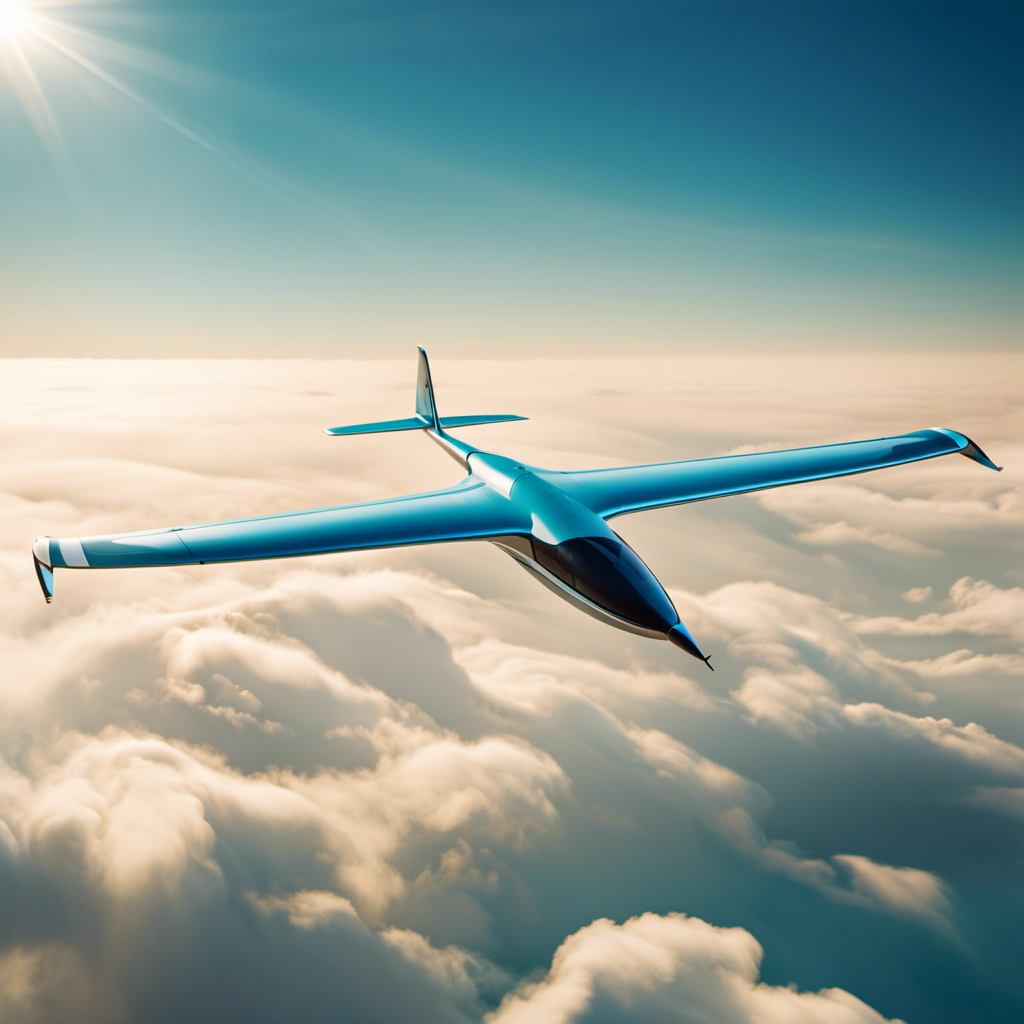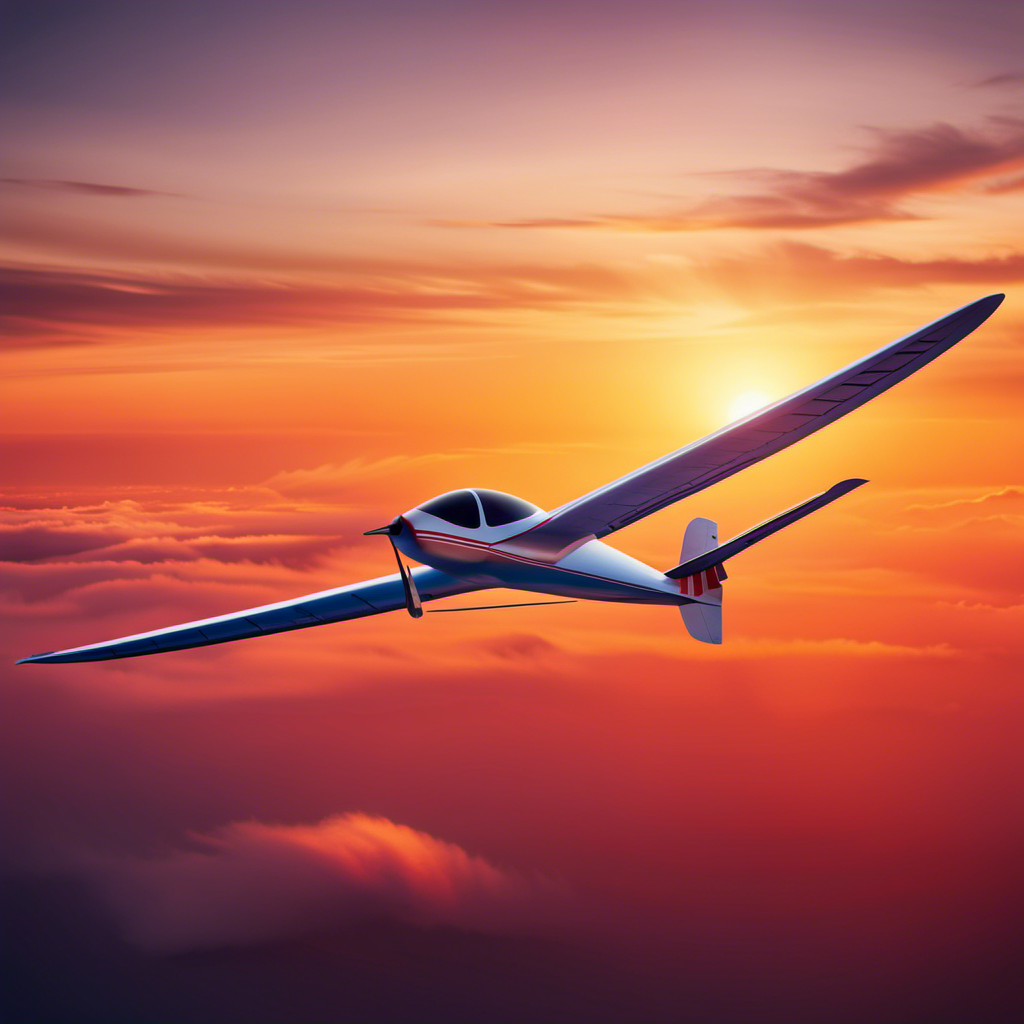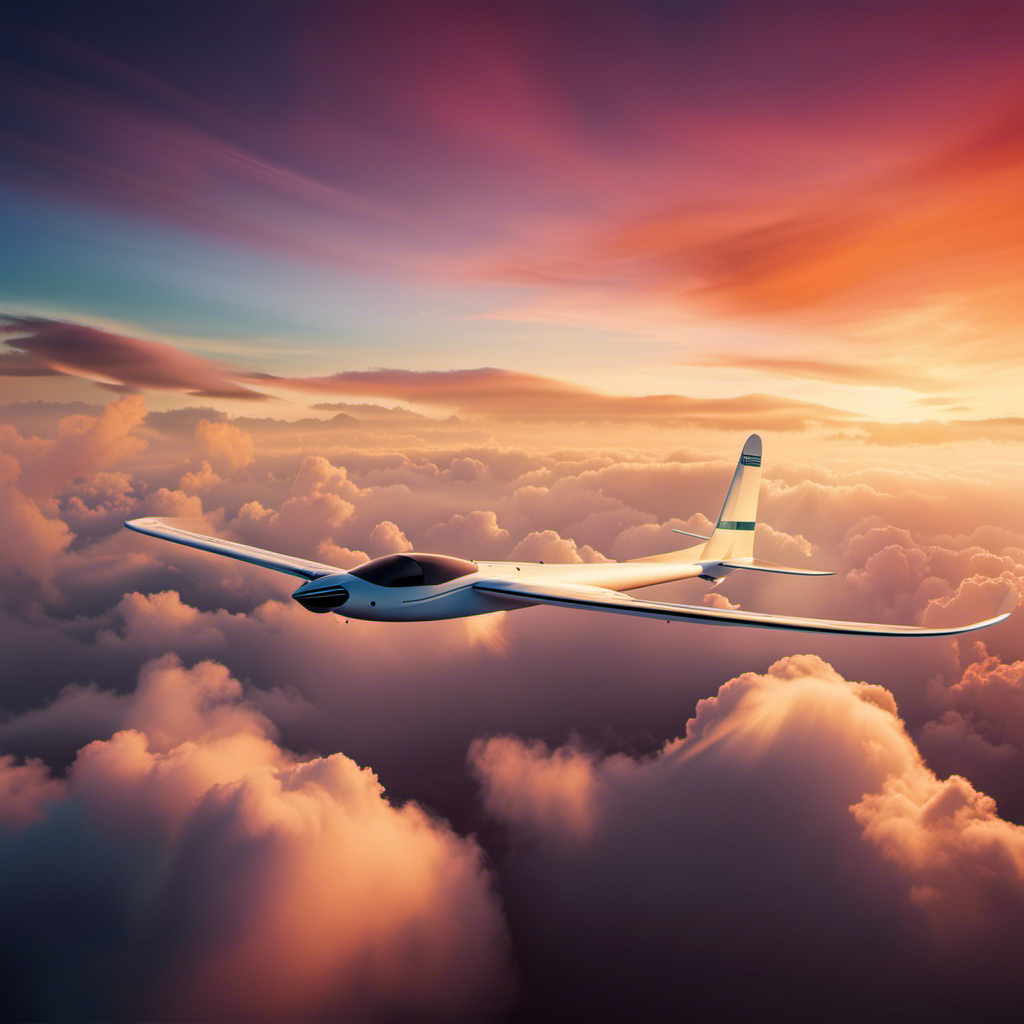Being a passionate pilot, I often find myself thinking about the future of aviation. The concept of an electric glider has especially captured my attention.
Just imagine, gliding through the skies in near silence, powered by clean and sustainable energy. It sounds like something out of a science fiction movie, doesn’t it? But the reality is, electric gliders are becoming more and more prevalent in today’s aviation industry.
In this article, we will explore the question: is investing in an electric glider truly worth it? Let’s dive in and examine the objective data and technical aspects to find out.
Key Takeaways
- Limited availability of charging infrastructure and potential increase in charging service costs may be a limitation for investing in electric gliders.
- Advancements in battery technology, charging infrastructure, and the integration of solar panels offer potential advancements for electric gliders, including longer flights and reduced weight.
- Regulatory considerations, such as certification requirements and operational limitations, need to be taken into account when investing in electric gliders.
- Electric gliders offer benefits such as eco-friendliness, low operating costs, and high resale value, but the decision to invest should consider personal preferences, flying goals, and the balance between current limitations and potential advancements.
Environmental Sustainability
Using an electric glider instead of a traditional one can help reduce carbon emissions and protect the environment. Electric gliders are powered by renewable energy sources, such as electricity from solar panels or wind turbines, which greatly reduces their carbon footprint. According to studies, electric gliders produce up to 75% less carbon dioxide compared to their conventional counterparts. This significant reduction in emissions contributes to the overall sustainability of aviation and helps combat climate change.
Additionally, electric gliders have the potential to promote the use of clean energy and inspire the development of more eco-friendly transportation solutions. Transitioning to electric gliders is a crucial step towards achieving a greener and more sustainable future.
Now, let’s explore how this shift can also lead to significant cost savings.
Cost Savings
By opting for an electric glider, you can save money in the long run. The savings primarily come from reduced electricity costs and lower maintenance expenses.
Compared to traditional gliders that rely on fossil fuels, electric gliders operate on electricity, which typically costs less per unit than gasoline or diesel. Additionally, electric gliders require less maintenance due to their simpler and more efficient design. The absence of a complex internal combustion engine means fewer moving parts that can break or wear out. Consequently, maintenance expenses are significantly reduced.
These cost savings make electric gliders a financially attractive option for pilots and glider enthusiasts. Moreover, the savings can be further maximized when considering the quiet and smooth operation of electric gliders, making them an appealing choice for a variety of applications.
Quiet and Smooth Operation
As a pilot, I’m always looking for ways to improve the flying experience for myself and my passengers.
Two key factors that greatly contribute to a superior flying experience are noise reduction and smooth operation.
Noise reduction not only enhances the comfort of the passengers but also improves communication between the pilot and air traffic control.
Additionally, a smooth operation reduces turbulence and vibrations, resulting in a more enjoyable and efficient flight.
Noise reduction
There’s no denying that noise reduction is a crucial factor to consider when deciding whether to invest in an electric glider.
Electric gliders have made significant strides in reducing noise levels, making them more appealing to pilots and reducing their impact on the environment.
The key to achieving noise reduction lies in optimizing the electric glider’s aerodynamics. By carefully designing the shape of the aircraft, reducing drag, and improving airflow management, noise levels can be significantly reduced.
In addition to the obvious benefits for pilots and passengers, noise reduction also contributes to a more sustainable and environmentally friendly flying experience. With quieter operation, electric gliders offer a more serene and enjoyable flight, enhancing the overall flying experience for everyone on board.
Enhanced flying experience
To enhance your flying experience, focusing on optimizing aerodynamics and reducing noise levels is crucial. When it comes to electric gliders, these two factors play a significant role in improving safety and ensuring a smoother ride. Here are three key elements that contribute to an enhanced flying experience:
-
Streamlined Design: By utilizing advanced aerodynamic principles, electric gliders are designed to minimize drag and improve efficiency. This allows for better maneuverability and increased speed, resulting in a more enjoyable and responsive flight.
-
Noise Reduction Technology: Electric gliders incorporate innovative noise reduction techniques, such as sound-absorbing materials and quieter propulsion systems. This not only reduces noise pollution but also enhances the overall tranquility of the flying experience.
-
Enhanced Safety Features: Electric gliders are equipped with modern safety systems, including advanced avionics and collision avoidance technology. These features provide pilots with real-time information and help prevent accidents, ensuring a safer and more secure flight.
Transitioning into the next section about ‘limited range and endurance’, it is important to consider the trade-off between performance and efficiency in electric gliders.
Limited Range and Endurance
The electric glider’s limited range and endurance may not make it worth the investment for some buyers.
While electric gliders offer many advantages, their range limitations and battery life can be significant drawbacks.
Electric gliders typically have a shorter range compared to traditional gliders due to the limitations of battery technology. The average flight time of an electric glider is around 1-2 hours, depending on various factors such as weight, weather conditions, and flying style.
This limited endurance can restrict the flying experience, especially for pilots who enjoy long-distance flights or soaring in thermals for extended periods.
Additionally, the need to recharge the batteries after each flight can be time-consuming and inconvenient, especially if there is limited availability of charging infrastructure.
These factors should be carefully considered before investing in an electric glider, as they may impact the overall flying experience and utility of the aircraft.
Moving on to the next section, let’s explore the limited availability of charging infrastructure and its implications.
Limited Availability of Charging Infrastructure
If you want to fly an electric glider, you’ll need to consider the limited availability of charging infrastructure and how it might affect your flying plans. The current charging alternatives for electric gliders are not as widespread or convenient as traditional fueling options for conventional gliders. This limited availability can have a significant impact on your flying experience and may require careful planning and consideration.
Here are three key points to keep in mind:
-
Limited Charging Stations: Finding a charging station specifically designed for electric gliders can be challenging, especially in remote or less developed areas. This can limit your choice of flying destinations and require you to carefully plan your routes.
-
Long Charging Times: Charging an electric glider takes significantly longer than refueling a conventional glider. This means you may need to allocate more time for charging, which can affect your overall flying schedule.
-
Impact on Power Grid: Electric gliders require a significant amount of power to charge, which can put strain on the local power grid. This may result in limitations on the availability of charging infrastructure or increased costs for charging services.
Considering these factors, it’s essential to weigh the benefits of flying an electric glider against the limitations of charging infrastructure. However, the potential for future technological advancements in charging alternatives and the reduction of impact on the power grid offer promising prospects for the electric glider industry.
Potential for Future Technological Advancements
Considering the potential for future technological advancements, you’ll likely see improvements in charging infrastructure and more convenient options for flying your electric glider. The future innovations in electric aircraft will revolutionize the way we fly, making it even more accessible and environmentally friendly. With advancements in battery technology, we can expect increased energy density, allowing for longer flight durations and reduced weight. Additionally, improvements in charging infrastructure will make recharging your electric glider faster and more convenient. Take a look at the table below to see some potential future innovations in electric aircraft:
| Future Innovations | Description | Potential Benefits |
|---|---|---|
| Advanced Batteries | Higher energy density and lighter weight | Longer flight durations and increased efficiency |
| Wireless Charging | Eliminates the need for physical charging cables | Convenient and hassle-free charging experience |
| Solar Panels | Integrated solar panels on the wings | Supplemental power and extended flight range |
As we continue to witness advancements in electric aircraft technology, it is crucial to consider the regulatory considerations that come along with it.
Regulatory Considerations
When it comes to regulatory considerations, it’s important to address safety standards and airspace regulations for electric aircraft. Electric gliders are no exception. Here are three important aspects to consider when it comes to electric glider regulations and airspace restrictions:
-
Certification: Electric gliders must meet the necessary certification requirements to ensure their safety and reliability. This includes thorough testing and compliance with established standards.
-
Operational limitations: Electric gliders may have specific operational limitations imposed by regulatory bodies. These limitations could include restrictions on flight altitude, range, or specific areas where they can fly.
-
Charging infrastructure: As electric gliders rely on batteries for power, the availability of charging infrastructure becomes crucial. Regulatory considerations should include guidelines for charging stations and ensuring their safe operation.
Understanding and adhering to these regulations and restrictions is essential for the safe operation of electric gliders.
Transitioning now to the next section, let’s explore the learning curve for pilots when it comes to flying these innovative aircraft.
Learning Curve for Pilots
Pilots may experience a learning curve when initially flying electric aircraft. As with any new technology, pilot training is crucial to ensure safe and efficient operation. Electric aircraft have unique characteristics that require pilots to adapt their flying techniques.
The electric propulsion system, for example, provides instant torque and requires pilots to be familiar with power management and battery limitations. Safety measures, such as proper pre-flight checks, monitoring battery levels, and understanding emergency procedures, are essential to mitigate potential risks. Furthermore, pilots must be trained on the specific handling and maintenance requirements of electric aircraft.
By equipping pilots with the necessary knowledge and skills, the learning curve can be effectively managed, ensuring a smooth transition to electric flight.
This prepares us to explore the next aspect of electric gliders: their resale value and market demand.
Resale Value and Market Demand
To get a sense of how much you can potentially earn from selling an electric glider, you should research the current market demand and resale value.
The electric glider market is experiencing significant growth due to increasing interest in eco-friendly aviation. Market trends indicate a strong demand for electric gliders, with many pilots transitioning from traditional gliders to electric-powered ones.
The resale value of electric gliders remains high, thanks to their advanced technology and sustainability features. When considering the potential earnings from selling an electric glider, it is crucial to factor in the market demand and resale value, as these factors directly impact the return on investment.
Understanding the current market trends will help you make an informed decision based on data-driven insights. Transitioning into personal preferences and flying goals, it is essential to consider individual needs and aspirations when investing in an electric glider.
Personal Preferences and Flying Goals
If you’re considering purchasing an electric glider, it’s important to think about your personal preferences and flying goals.
When it comes to flight training, electric gliders offer a unique opportunity for pilots to enhance their skills and experience the thrill of silent flight. With advancements in technology, these gliders have become more efficient and reliable, making them a safer option for pilots. Safety measures such as parachute systems and advanced avionics further ensure a secure flying experience.
Additionally, electric gliders are environmentally friendly, producing zero emissions and reducing noise pollution. Their low operating costs and maintenance requirements make them a cost-effective choice for pilots.
Ultimately, your personal preferences and flying goals should guide your decision, but the benefits of electric gliders in terms of flight training and safety measures make them a worthy investment.
Frequently Asked Questions
How does the electric glider contribute to environmental sustainability compared to traditional gliders?
The electric glider offers significant environmental benefits compared to traditional gliders. It reduces carbon emissions and noise pollution, contributing to sustainability. Additionally, it provides cost savings by eliminating the need for fossil fuels and reducing maintenance expenses.
Can the cost savings of owning an electric glider outweigh the initial investment?
The cost effectiveness of owning an electric glider can outweigh the initial investment through long term savings. Compared to traditional gliders, electric gliders have lower fuel and maintenance costs, resulting in significant financial benefits over time.
What makes the operation of electric gliders quieter and smoother compared to conventional gliders?
Electric gliders achieve quieter and smoother operation through advanced noise reduction techniques and enhanced efficiency. Electric glider noise reduction technologies minimize motor noise, while improved aerodynamics and propulsion systems contribute to a smoother flight experience.
Are there any solutions to overcome the limited range and endurance of electric gliders?
There are solutions to overcome the limited range and endurance of electric gliders. These include solar-powered charging to extend flight time and improve battery capacity to increase the overall range of the glider.
What are the potential advancements in technology that could improve the performance of electric gliders in the future?
Potential advancements in technology could revolutionize electric glider performance. With breakthroughs in battery capacity, aerodynamics, and lightweight materials, the range and endurance of electric gliders could soar to unprecedented heights.
Conclusion
In conclusion, investing in an electric glider presents a compelling opportunity. Not only does it contribute to environmental sustainability, but it also offers cost savings and a quiet, smooth operation.
Despite its limited range and availability of charging infrastructure, regulatory considerations, and the learning curve for pilots, the potential for resale value and market demand shouldn’t be overlooked.
Ultimately, the decision to invest in an electric glider will depend on personal preferences and flying goals. With its promising benefits, it’s worth considering as a viable option for the future of aviation.
With a heart that soars as high as the skies, Aria, affectionately known as “Skylark,” is the driving force behind Soaring Skyways. Her journey into the gliding world began as a young dreamer gazing up at the soaring birds, yearning to experience the weightlessness and freedom they embodied. With years of experience both in the cockpit and behind the scenes, Aria’s commitment to the gliding community is unwavering.










